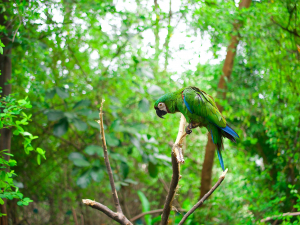Why a collective vision with indigenous peoples ?
We believe that it is extremely important to collaborate concretely for the first peoples, especially in the Amazon, by creating meetings and exchanges with them and the European actors of all circles.
We have many reasons to believe that it is essential today to hear and support these peoples. First of all, first nations have maintained strong ties to their environment, a living relationship to nature. This connection remained intact despite the influence of the West with its ideas of progress, its exchange principles based on money, its vision of education and religion. For the majority of the first peoples, the notion of respect and the principle of inclusiveness represent two essential notions in their relationship to society and nature, but also in a more global way. They feel a strong love for nature and the forest and would be willing to put their lives on the line to preserve their environment. At present, many of these people still have a nomadic way of life. Others live in complete autarky, far away from the modern world, far from the madness of markets and the influence of politics.
Moreover, despite a complex history often tinged with colonization and genocide, these peoples have always maintained a resilient dynamic, a sense of harmony and common value. These values still allow them today to live in symbiosis with virgin environments. Today, these people are extremely important for the preservation of these last virgin spaces, especially the Amazon. They represent the main problem of mining and logging companies, because they prevent them from freely accessing the resources of the forest. These colonists represent the most formidable threat to forest peoples, as shown by the atrocities committed in the Amazon by gold diggers and other adventurers.
The presence of gold diggers, for example, has a devastating impact on indigenous populations. They corrupt local leaders in order to stay in place and create a climate of instability within the group, they abuse women, also transmit diseases, etc.
(Testimony around the Yanomani people)
And when they are not directly complicit in such practices, central governments and local authorities turn a blind eye. “The Amazon is a land without law”. Politicians are often themselves big landowners who facilitate or even provoke invasions, deforestation, monoculture and the progress of mining companies. The damage inflicted on the natives is often terrible.
The Amazon has 250,000 Indians and an even larger number of caboclos, mixed populations living along the rivers and practicing subsistence horticulture. Many of these forest dwellers are entirely dependent on them for their daily food, materials, income, social reproduction and medicines, through complex and adapted systems that combine hunting, fishing, gathering, arboriculture and permanent agriculture.
The education of children, the care of the elderly and the infirm, the organization and management of many rituals, the maintenance of order and the common management of community choices and needs complete their activities. Their knowledge of the living is an integral part of their first learning. For example, a child of the Ashaninka people, girl or boy, will have learned from the age of 5 with his father, to recognize all the poisonous plants and animals of the forest, but also all the antidotes to seek treatment or to help a loved one. At the age of 7, he will be able to find himself alone in the heart of the forest and to shelter there, to locate there but also to feed there by hunting and fishing.

For indigenous peoples, the preservation of forests and the promotion of sustainable agriculture go hand in hand with the preservation of traditional knowledge. In the Amazon as elsewhere, culture is directly related to the preservation of the environment. For some tribes, to make known their cause is a question of life or death. We can really help them to maintain their lifestyles and traditions.
But these peoples also carry great teachings for us Westerners. They remind us how to connect to nature. It is therefore urgent that we give them a maximum of echo here by integrating them into our reflections, projects and visions. Developed countries like ours have lost sight of their connection to the environment. These people show us alternatives to our idea of progress. For example, they see plants, animals, and humans as one entity. They consider the forest as an ecosystem of which they are part, thank the trees before cutting them, etc. This encourages reflection.
The medicine of the Amazon is of a wealth and unsuspected effectiveness. It offers a harmonious approach with the essence of the living, unlike our medicine that sees this living only as a raw material, reproducing and using the molecules, without understanding the precious mechanism of coherence of the plant as a whole. Some Western doctors suggest that this restricted and fragmented perception is one of the reasons for all the side effects of our medicine.
It is to broadening our vision that these peoples invite us, far beyond our ideas of sustainability. They allow us, with simplicity, through the path of the heart, to reconnect together and to nature. They offer answers to most of our concerns, because by discovering the immensity of Indian wealth, we discover what they can teach us in terms of relationships with space and nature, from healthy relationship to life, medicine, inclusive and humanistic social organization, etc. Faced with the current challenges of global warming, their practices and knowledge are certainly worthy of the greatest interest for humanity in general.
